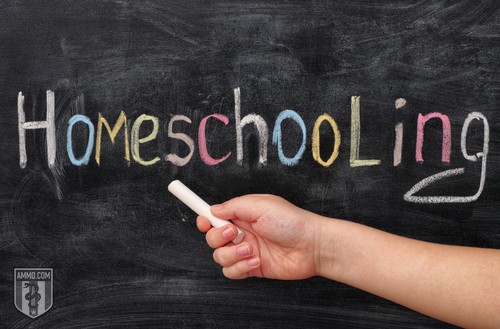Youth Homeschooling: A Smart Parent's Guide to Successfully Homeschooling Children
You're free to republish or share any of our articles (either in part or in full), which are licensed under a Creative Commons Attribution 4.0 International License. Our only requirement is that you give Ammo.com appropriate credit by linking to the original article. Spread the word; knowledge is power!
 The world of homeschooling is changing. It’s no longer exclusively long skirts and religious fundamentalists. Instead, it’s doctors and lawyers, soccer moms, and people who’ve decided they’ve had enough of the American education system.
The world of homeschooling is changing. It’s no longer exclusively long skirts and religious fundamentalists. Instead, it’s doctors and lawyers, soccer moms, and people who’ve decided they’ve had enough of the American education system.
According to the National Home Education Research Institute, it’s estimated that over two million kids are now homeschooled, up 75 percent since 1999, and those numbers continue to rise. Within the next five to 10 years, expect to see exponential growth as more and more people get fed up with the system and recognize the benefits homeschooling brings.
What Public School Education Is Lacking
When you think back on your own education, you probably remember a huge focus on reading, writing, and arithmetic, but you know that’s not the case with today’s youth. With Common Core, it now takes abstract thinking to understand that 7+8=15. Instead of the KISS principle (Keep It Simple Stupid) of simply adding seven and eight, our children do this: 7+3=10, 8-3=5, 5+10=15, therefore 7+8=15. Or this: 7+7=14, 7+1=8, 14+1=15, therefore 7+8=15. What happened to just teaching them 7+8=15?
What it comes down to is that the American school system is failing our children in so many ways. It’s forgotten to teach our children how to learn. When children learn how to learn, they understand how to think and problem solve. Learning becomes something fun that they naturally crave to do, not something that’s required because it’s going to be on a standardized test.
And are the school systems preparing the nation’s kids for life after high school? Heck no. Instead of detailing what they are learning, here’s a list of some of the life skills children aren’t learning in school:
- How to find a job
- How to build and manage a budget
- How to invest money
- How to buy a home or car
- How to grow food
- The voting process
- The tax system
- Proper sexual education
- Retirement planning
- First Aid or CPR
Why You Should Consider Homeschooling

People homeschool for a variety of reasons. Some want more of a say in their children’s education, and for others, homeschooling makes travel possible. And then there are those who pull their children out of public schools because of medical issues, behavioral challenges, or bullying.
But there’s even more reasons to consider homeschooling. Here are just a few:
- Better Education: It’s a fact that homeschooled students, on average, receive a better education. On standardized testing, homeschooled students scored 15 to 30 percent higher than their public school peers and have above average scores on the SAT and ACT.
- Enrich Strengths: With a homeschooling curriculum, you can work with your children’s strengths, enriching their educational experience and providing challenges not available in the public school setting.
- Strengthen Weaknesses: Every child has weaknesses when it comes to learning, and with homeschooling, you’re given the opportunity to strengthen them with one-on-one focus and attention.
- Set Your Own Pace: When you homeschool, your children may breeze through grammar and phonics, but struggle in mathematics. Instead of scraping by and settling for mediocrity, you set the pace to help your child learn and put extra time and effort where it’s needed.
- Supplement: When you homeschool, you supplement your children’s education to make it more exciting and fulfilling. From projects to YouTube videos to field trips, the homeschooled child gets to experience education outside the classroom. If your child expresses special interests, homeschooling gives you the freedom to explore them.
- Public School Perks: Just because your children are homeschooled doesn’t mean they can’t be active at school. Specialty classes like PE, art, and music, as well as school clubs, organizations, and sporting teams are available to homeschooled students within a school district.
- Teach Values: When you teach your children at home, you teach them your values, morals, and beliefs. You teach them what you believe in and what’s important to you. As a bonus, values like work ethic and responsibility are established simply by the nature of homeschooling – allowing families to create stronger bonds.
- Socialization Without the Mess: Homeschooled children are no less socialized than those who attend public or private schools, yet they don’t have to deal with the chaos of school drama. Peer pressure, bullying, and cliques are avoided, as well as the exposure to drugs, promiscuous behaviors, and violence. By scheduling play dates to joining sports teams, homeschooled kids interact with other kids often.
- Religious Education: In a world where people push to have God taken out of the Pledge of Allegiance, religious education and beliefs are of the utmost importance. The school systems teach about Islam, but are afraid to mention Christianity. Homeschooling your children allows you to put God back into your children’s education and teach them your beliefs.
- Behavior Issues: For many of those who have children with behavior problems, ADD/ADHD, autism, or other learning difficulties, homeschooling proves to be the right option. Too often, kids with special needs fail in America’s school system, but by homeschooling, parents can meet each student’s individual needs to ensure success.
- Reduce Government Influence: If you don’t want the government controlling your child’s education, than traditional teaching establishments aren’t going to work. With Common Core, liberal teaching unions, and far-left philosophies, many parents are pulling kids out of public school and homeschooling.
- A Nontraditional Approach: Sometimes you just want to do something different. You want your children to get their hands dirty. You want them to learn through an interactive world, experience museums and art galleries. Along with reading, writing, and arithmetic, you want them to learn about botany, stewardship, and philosophy. Homeschooling allows you to find what works for your family, and implement it into your children’s education, regardless of what it is.
- A World Scholar: Another bonus of homeschooling is the mobility it offers both students and families. Because you’re not bound to one location for nine months a year, you can travel and expose your child to different places, allowing him or her to become a student of the world, not the classroom.
- A Safe Learning Environment:With homeschooling you can skip dealing with the security measures of a public school and avoid walking through a security metal detector everyday. You can also rule out the possibility of your child being bullied or harmed by other students altogether.
What it comes down to is what kind of life do you want your children to have? What kind of life do you want them to live? If the traditional public or private school system isn’t providing it, then it’s up to you to do so.
Other Homeschooling Considerations

Even though homeschooling sounds fantastic – which it can be – there are other things to consider. Here are some of the most important:
- School Days: Although your child’s school day will be much shorter than the traditional, it still needs to happen consistently. Make a pre-determined schedule detailing what gets done when, and hang it on the wall where everyone can see it.
- Adult Supervision: No matter what your children’s ages, an adult needs to be present to facilitate learning, answer questions, and ensure work gets completed to the best of the students’ abilities. This takes time and dedication, and for single-parent households or those with two parents working outside the home, schedules will have to change to accommodate homeschooling.
- Cost: It’s estimated that the average homeschooling costs around $900 per student per year, but that includes those who participate in expensive, specialized curriculums. In reality, the cost is typically much less. If the price of homeschooling is what’s holding you back, look into free, online curriculums or join homeschooling Facebook groups, as many parents are willing to share and trade teaching materials.
- Multiple Grades: If you have multiple children, chances are you’re going to be homeschooling kids in multiple grades. While it sounds crazy and chaotic, it doesn’t have to be. Many parents suggest teaching a specific subject to all the students at the same time, just on different levels and with different applications. This allows you to work as a group first, then individually to grasp concepts and apply the knowledge. Have older children help the younger ones – like your 10 year old reading a picture book to your five year old—and they’re learning simultaneously.
Avoiding the Indoctrination of Public Schools
Homeschooling has other benefits as well: Namely avoiding the left-wing, anti-Christian and anti-American indoctrination of public schooling. Most readers are probably familiar with the Marxist agenda pushed in post-secondary education. However, less known is that this agenda is prevalent and powerful even in elementary school. The indoctrination that takes place in college is largely made possible by the indoctrination that takes place over the course of 12 years in public education – and frankly, the private schools aren’t much better these days.
We have ample examples of extreme ideological education in our nation’s schools. For instance, four states currently require “LGBT history” to be taught. You can easily find curricula for teaching transgender ideology in elementary schools online. Elementary schools have likewise begun teaching young children about “white privilege” ideology.
Are these extreme cases? Surely, but it is their extremity that makes them noteworthy. Because of its size, California often determines what is taught in America’s classrooms. Textbooks must sell there. So what’s taught in San Francisco and New York today will be taught in your town as well.
But there's a broader question of indoctrination. By this we don’t mean “teaching children things we don’t like,” nor do we propose that the solution is more conservative and libertarian teachers. The problem isn’t children being indoctrinated in the “wrong” values, but the indoctrination of children – period.
Indoctrination is propagandizing at children in any form rather than providing them with critical reasoning skills. The lack of thought is what makes for indoctrination. Young people should not have a worldview propagandized at them. They should be provided with critical thinking and formal logic skills to reason out solutions for themselves.
There is no evidence that the public schools can ever be anything more than indoctrination centers. The prevailing ideologies of the time will always predominate in this environment. Indeed, these were the grounds on which John Stuart Mill opposed state education, though he did favor government subsidies to provide the poor with access to schooling. It’s not necessary for there to be an all-encompassing conspiracy to hoodwink children. Even if most school teachers were on the same level, one would still be putting their children in the hands of an agenda controlled by the left-wing teachers union and Department of Education – the heavy hitters in the education industry.
The failures of traditional schooling go far beyond one child’s experience. There is a broader social problem when entire generations are indoctrinated in ideologies hostile toward Christianity, America and freedom – especially when these generations aren’t provided with the skills to “think” their way out of the box that traditional education has put them in.
Turn on the news to see the real-world consequences of traditional education. We are seeing the flaws in this system manifest in extreme ways every day.
How to Get Started
 If you think homeschooling may be the right choice for you and your children, here’s how to get started.
If you think homeschooling may be the right choice for you and your children, here’s how to get started.
Check Your Local Legalities
While homeschooling is legal in all 50 states, each state has its own regulations. To find out the laws in your state, check the Home School Legal Defense Association (HSLDA) website. Things that fall under state regulation include the age at which a child must start school, how many mandatory school days and hours, what kinds of records must be kept, what subjects must be taught, and if there is a specific curriculum that should be in place.
Also find out your state’s process for notifying the school district of your decision to homeschool, what paperwork must be completed, and how to enroll in the state’s standardized testing.
Pick the Right Curriculum
When it comes to picking your children’s curriculum, the choices can be overwhelming. Instead of getting lost in the options, browse programs to see which matches your teaching philosophies and goals. Read reviews, and search homeschooling forums to see what people say about the ones you’re considering. If the price tag weighs heavy on your options, don’t worry – there are plenty of affordable programs available and you can even find some that are free.
When considering curriculums, pay attention to teaching methods. Some curriculums primarily rely on videos, while others have a heavy reading slant. Choose one that works best with your children’s learning styles and interests, as well as your own teaching methods, to make homeschooling more enjoyable for everyone.
Depending on what type of curriculum you decide to go with, you’ll also need supplies. Many curriculum packages come with books, videos, and worksheets, but you may want to incorporate other things – such as picture books that reinforce ideas or hands-on activities to see concepts in action.
Build Your Lesson Plans
Because each child has a mandatory set amount of days he or she must be in school, you’ll need to make sure you provide learning on those days, which is easily accomplished through lesson planning. When you lesson plan, you’re less likely to get distracted, keeping your children on track throughout the school day and the year.
When you’re building your lesson plans, remember to utilize the benefits of homeschooling. Plan in activities and field trips to show your children real-life applications of the concepts they’re learning in the classroom. If there are specific lessons you want your children learn, be sure to incorporate them into your lesson plans.
Determine a Schedule
When it comes to homeschool scheduling, you have a lot of freedom, both day to day and throughout the year. Just because the traditional school system has seven to eight subjects a day, every day, doesn’t mean you have to. Subjects can be blocked off by the semester, taught every day, or once a week. Certain subjects, such as math, reading, writing, and spelling are based on skill development and should be done regularly, while others like literature, geography, and science don’t need the daily repetition.
You’re also able to set your own daily schedule, one that works well with your family and its needs. If you don’t want to start your school day until everyone’s had breakfast and chores are complete, that’s fine. But whatever you do, stick to your schedule. Without it, things quickly become disorganized and chaos ensues.
Plan Your Space
Organization is the key to successful homeschooling. From physical organizers to keep schoolwork tidy to containers for art supplies, you need to organize when you homeschool. Having a designated area to do schoolwork is also important. It not only keeps everything and everyone together, but it helps you get into the school mindset. If work is done in the living room with the television on, there’s not a whole lot of information being retained. But if your child sits down at the same desk each day to do his or her work, the brain automatically kicks into learning mode.
Set Rules and Follow Them
Just like a teacher, you must have rules in the classroom and expect them to be obeyed. And if one student acts out, you can’t stop the school day to deal with his or her behavior. There are lessons that need to be covered and things that need to be learned, and that’s why you need a specific set of school day rules. While some of these may be your normal house rules – things like no yelling or always tell the truth – others may be more specific to school, such as no phones between the hours of 10am and 2pm. Once your rules are established, post them somewhere visible so both you and the children remember what they are..
When a rule gets broken, both you and the child should know what the consequence is going to be. Some homeschooling parents use a three-strikes-and-you're-out rule, which consists of an hour-long detention where either extra school work or chores are assigned. Others may issue a timeout to help the child regroup and refocus. If there’s work that didn’t get completed because of negative behaviors, it’s given as homework and the student must complete it after regular lessons are completed.
Perhaps more important than disciplining your child when he or she breaks the rules, is remembering to reinforce positive behaviors. The more good behavior is encouraged, the more you’re likely to see it. Daily sticker charts work well for younger students and older children are often receptive to working towards a class goal, such as a movie or ice cream.
The kids must remember their rules, but you need to remember yours as well. Here are five rules that every homeschooling parent should follow:
- Keep it simple
- Set expectations
- Be consistent
- Follow through
- Stay calm
In the traditional classroom, each student has a job he or she is responsible for, and the same thing should be true for the homeschooled student. Schedule in clean-up time, as well as household duties and chores that each child is responsible for – including dishes, sweeping the floor, or wiping the counter. This teaches children responsibility and accountability, and reinforces the idea of the family as a team.
Find Your Support
If you’ve already started talking to your friends and family about homeschooling, you probably realized not everyone is going to support you. People will tell you that you’re crazy, that you’re damaging your kids for life, and that there’s no way you or your kids are smart enough/behaved enough/organized enough to actually do it. They’ll tell you that you’ll fail. But don’t believe them. You can homeschool and your kids can thrive in that environment. But to do so, you need to have support.
Find other homeschooling parents, join a local homeschooling organization, or follow Facebook groups and blogs. By giving yourself access to others in the homeschooling realm, you find support, gain confidence, and give yourself a plethora of information and experience at your fingertips. Other homeschooling parents help you come up with ideas, share curriculums, and even coordinate field trips and afterschool activities. Plus, these parents understand. They get why you’re homeschooling your children and encourage you to keep going, and perhaps that’s the thing you need more than anything else.
Is Homeschooling Right For Your Family?
If you’re wondering if homeschooling is right for your family, only you can answer that. Spend some time researching homeschooling options, reach out to other homeschooling families, and figure out how your life has to adapt to make homeschooling fit. Check out reputable websites and communities for homeschooling, including the Home Schooling Legal Defense Association, HomeSchool.com, and national and local homeschooling associations to learn more.
Parents
- Youth Gun Safety: A Smart Parent's Guide to Keeping Kids Safe
- Youth Homeschooling: A Smart Parent's Guide to Successfully Homeschooling Children
- Youth Hunting: A Smart Parent's Guide to Safely Hunting with Kids
- The U.S. Constitution: A Smart Parent's Guide to America's Most Important Document
- Protecting Your Family: A Parent's Guide to Self Defense and Concealed Carry (CCW)
- The U.S. Constitution and Bill of Rights: An Interactive Guide to the Articles and Amendments
- The History of Private Schools: How American Education Became a Political Battleground
- The United States Declaration of Independence: An Interactive Guide to Our Founding Document
- American Education: Child Indoctrination, Struggle Sessions and Debt Slavery
- Jefferson Davis and the Rise and Fall of the Confederate Government: A Parent's Guide
